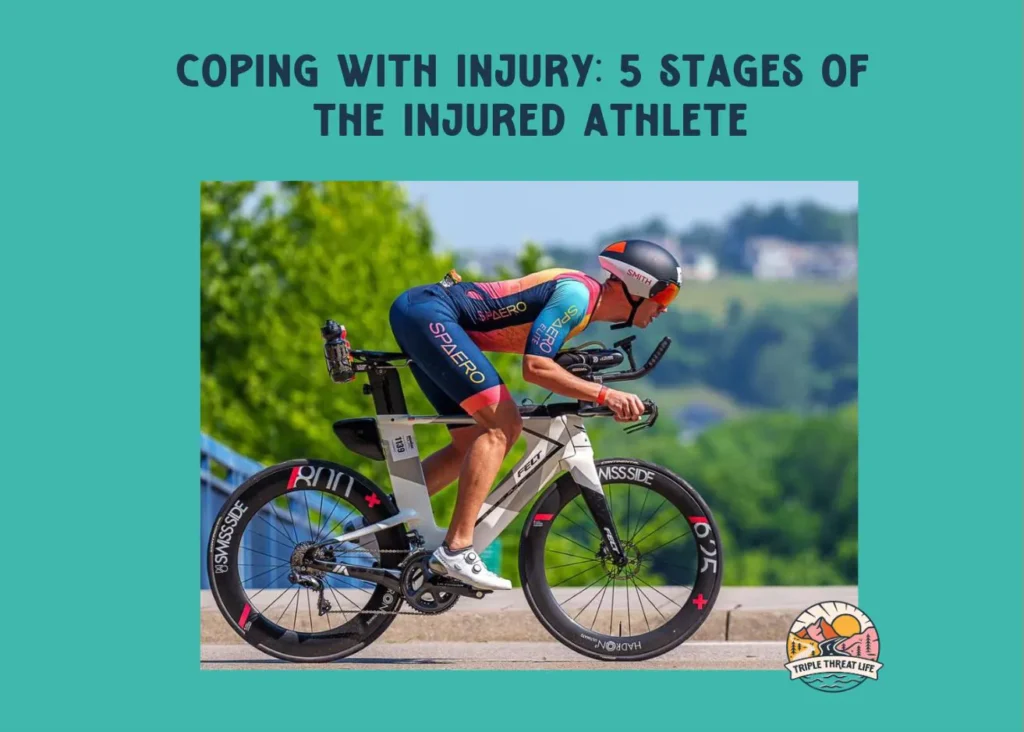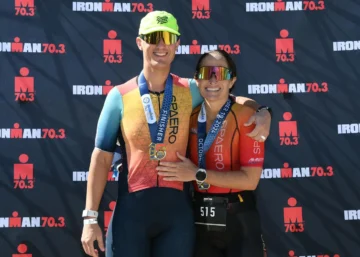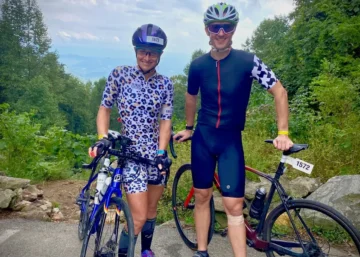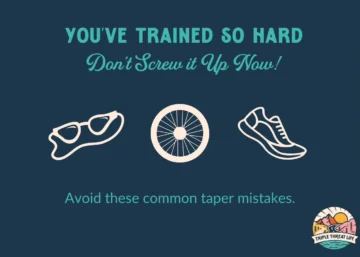
Today we have something special in store with our first guest post!
Almost one year ago this month, my husband Matt was injured on a group ride while we were training for Ironman Florida.
It’s been a long road to recovery (much longer than either of us anticipated) and as a result our race season has looked a bit different this year.
Although he’s still not back to 100%, he’s progressed through the 5 Stages of the Injured Athlete and has come out on the other side, a bit bruised but more grateful and with some hard-earned wisdom to share.
If you’ve suffered an injury, you know how deeply our athletic identity is tied in with sense of self. When you can’t do the things you love, it’s easy to lose sight of your purpose.
If you aren’t an athlete anymore, then who are you?
Read on to discover Matt’s story and to learn five steps for coping with injury.
It happened as if in slow motion.
The rider in front of me did a somersault over his handlebars and went down in a heap.
I had nowhere to go, so I hit the brakes and turned sideways. With a giant thump, I landed on my hip. I laid there for what seemed like minutes, but in reality, it was only a few seconds.
I got up and dusted myself off, surprised to find that there was no road rash. Even my bibs survived unscathed.
Next, came the survey of my bike. Remarkably, there wasn’t a scratch on it. My friend sustained more visible damage, some road rash and broken handlebars, but we were able to finish the ride and limp back home.
I didn’t know then, but it would be a long road back from that day.
That ride was in early September of 2023. We had a large group of triathletes getting ready for Ironman Florida, and we’d been building up mileage. The plan that day called for an 80-mile training ride.
There were several athletes who were new to riding outside and preparing to do their first full distance Ironman. It was a lot of fun to join along on their journey and to watch them improve by leaps and bounds.
The best way I could support my friends was to come up with new routes for us to ride. As the only person in the group not actually doing the race, my main job was to sit on the front, guide the group, and set a comfortable tempo.
After being on the front for the first 30 miles of the ride, I decided it was time to take a break, and I rotated to the back of our five-person train. Not three minutes later, I learned a valuable lesson about riding with new cyclists and how their lack of experience can impair judgment when signaling road hazards.
In this case, it was a baseball-sized rock that wasn’t called out, which sent the rider in front of me over his bars and took me down with him. I’ve since updated my pre-ride safety talks about the importance of proper signaling and spacing between riders, but on that day, the damage had already been done.
At that point, we were 40 miles into our 80-mile ride. We were able to get my friend a car ride back home, but with my trademark combination of mental resilience, stubbornness, and more than a little stupidity, I gutted out the last half of the ride unable to push much power on my left side.
I can only describe the next five weeks as a journey through the five stages of grief.
First, it’s denial.
“It’s only a deep bruise. Just give it time to heal. You still have three weeks until Augusta 70.3. You’ll be fine by then.”
The last few weeks of 70.3 prep weren’t ideal, as you might expect. But I made it to race day and decided to give it a go.
The first signs of trouble came on the bike.
That brought on stage number two: anger.
“What’s up with my power? I’m pushing so hard but not getting anywhere close to my target!”
After ruminating on that for an hour or so, I managed to move on to the bargaining phase.
“Just get me off the bike. I know I can run.”
And run I did. I came out of T2 full gas, was running my goal pace, and having a great time… for the first four miles.
Then, the wheels well and truly fell off. My pace started to creep up. I could feel my hip start to fatigue, which made it hard to maintain good turnover.
After seeing mile splits almost three minutes off my target pace, the depression kicked in.
“Something must really be wrong with me. Just a few weeks ago, I was fit enough to smash my PR at this distance.”
Eventually, I did hobble across the line. That night after the race, I knew it was finally time to use my doctor brain and get some imaging done. (I’m a family medicine physician who specializes in sports medicine.)
The MRI showed a 7-centimeter tear through my gluteus maximus muscle with a significant hematoma. My fall to the ground the day of the crash had essentially sheared the muscle.
Well, that certainly explained why the race didn’t go well. It was then that I finally made it to acceptance.
Despite the physical appearance of nothing more than a bruise, this was a significant injury. It would take a lot of time and effort to get back to where I was before the crash.
The hematoma was aspirated, and we threw some prolotherapy at it for luck. Four injections later and that portion of the recovery process was done.
I visited a physical therapist and got some exciting resistance band exercises that my wife had to consistently remind me to do. About a month later, I could start doing some easy rides.
Meanwhile, there was still much work to be done on my swimming form. But I was a long way off from being able to do any significant runs.
I remember briefly jogging next to my wife during Ironman Florida to see how she was doing. Her response was, “Are you sure you should be running?”
It’s been a long build back, which included a lot of frustration and telling myself to be patient. Those who know me personally are aware that I’m very patient with others, but I have zero patience with myself.
I had big goals for this year, which I’ve pushed back six months, and I’m still not sure that I’m as ready to take them on as I was prior to my injury.
Over the past few months, we’ve finally been able to start doing some faster running. We’ve added in heavier weight training in the gym, and my glute still likes to remind me that it’s not all the way back to full strength.
I’ve been able to do a few races this year: St. Anthony’s Olympic and Vilano Beach Olympic. These races went reasonably well in light of where I’ve come back from, but still far short of where I want to be.
(Reference my previous statement about not being patient.)
But, my swim form has improved. My power on the bike is way up (likely helped by a few extra pounds accumulated during the I’m-injured-woe-is-me-funk I was in for a few months) but also from quite a bit of dedicated time on the trainer. The run is a long way off, but has been much better as of late.
I feel like I’m finally starting to see the light at the end of the tunnel.
Looking back, I would say that the mental side of the recovery has been most challenging. How could an injury that seemed like nothing but a bruise set me back almost 8 months?
I know I was lucky that things weren’t worse from the crash, and the injury allowed me to focus on areas that I’d been neglecting.
Our training group made it to the start and finish line of Ironman Florida. We had a party at our house where we celebrated the accomplishments of a wonderful group of triathletes. I later told my wife that by helping them, in some small way, get to the finish line, that gave me more enjoyment than all of my personal successes in triathlon.
Maybe it took being hurt to give me a bit more perspective. It’s certainly taught me to have more gratitude for being healthy and able to do the sport I love.
And to give a more robust safety talk at the beginning of group rides.
About Matt Vermeer:
Not only is Matt a triathlete, he’s also a Primary Care Physician who specializes in Sports Medicine.
He completed his undergraduate degree at The University of South Florida and attended medical school at St. George’s University. In the past, he worked with the medical staff for MLB teams like the Philadelphia Phillies and Toronto Blue Jays. For three years, he was part of the medical team for the Tampa Bay Rowdies, a pro soccer team in the USL.
He joined Dr. John Ness Family Medicine in October of 2022 and specializes in non-operative orthopedics including prolotherapy and PRP.
Coping with Injury: 5 Steps to Recovery
Although we hope you never get injured, there’s a high likelihood that some type of setback will happen during the course of your athletic career. Instead of feeling defeated, there are several things you can do to help accelerate recovery and come back stronger than ever.
Matt and I collaborated to come up with this 5 step guide for athletes coping with injury.
1.Focus on what you CAN do instead of what you can’t do.– When you’re injured, it’s hard not to think about all the things you can’t do. In Matt’s case, we tried to shift perspective and focus on what he could do. (As triathletes, we’re lucky because there are three sports to choose from.) Matt could still swim, so we focused on doing drills and analyzing his form, making goals for improvement. After a month, he could get back on the bike and do easy spins on the trainer. He used that time to build up his aerobic base, an area that had been lacking before the injury. He could also do rehab exercises in the gym.
2.Attack your rehab like training.– As an injured athlete, one of the most important things you can do is work on rehabbing the injury. For Matt’s glute tear, this meant a lot of single leg balance work. Don’t whine about doing rehab and don’t neglect it. Attack your rehab with the same intensity that you train. Schedule it just like you would a regular workout. Rehab is what will help you recover faster and come back stronger.
3.Give your body what it needs to recover.– This is an area that’s over overlooked. When recovering from an injury, you must give your body what it needs to recover. This means quality sleep, adequate hydration, good nutrition, and massage. Set yourself up for success by supplying your body with the protein and nutrients it needs to rebuild. Also, massage can be used as a tool to break up scar tissue, improve mobility, and address gait imbalances that might arise from an injury.
4.Have a realistic timeline, and expectations, for recovery.– This is a hard one because only your body knows how long it needs to recover. In Matt’s case, he was able to starting riding the bike much sooner than he was able to start running. The timeline for recovery must be flexible. Expect that you might have a few setbacks. Also, have realistic expectations. If it’s a significant injury, don’t expect to jump back in after several months and be right where you were before the injury. Yes, there might be a loss of fitness, but more importantly your body has to learn how to fire your muscles properly again and adjust to any gait imbalances (this is why rehab is so important!)
5.Soreness is ok. Pain is not.– Once you’re able to get back to regular training, remember Matt’s cardinal rule. Soreness is ok. Pain is not. Many athletes have a hard time distinguishing between the two, so here’s a description. An achy or tight muscle, or soreness that improves, or doesn’t get any worse, with exercise is typically fine. Some soreness is expected as your body adjusts to the new normal. However, pain that’s sharp or intense is not. Pain is your body’s way of telling you that something is wrong. Listen to it. If you feel pain, stop exercising and take some more time off. Pushing through pain is a surefire way to set yourself back even further. The recovery will take longer, or worse, you might not ever fully recover because of the continued damage.
Question of the Day:
Georgia: I have flat pedals on my bike, but want to learn how to use clipless pedals. It looks scary! Any tips?
Brittany: Totally understandable. We’ve all been there! It can be intimidating making the switch from traditional flat pedals to clipless pedals, but it doesn’t have to be scary.
For those who don’t know what clipless pedals are, it’s a two-part system where a cleat on the bottom of your cycling shoe attaches to the pedal on your bike. The benefit of clipless pedals over flat pedals (that you might see on a beach cruiser or hybrid bike) is that they allow you to take a full pedal stroke: you can push down with your glute and pull up with your hamstring. Flat pedals only allow you to push down, which restricts muscle recruitment and efficiency.
There’s a wide variety of pedal types: Garmin, Wahoo, Shimano. Matt has Garmin power pedals, and I have Look Keo pedals. Whatever kind you get, make sure that you purchase compatible cleats. Also something to consider is that many cleats have different degrees of float, which is how much they rotate from side to side. Some cleats are fixed, but most people like a bit of play.
This is how they work. You place your cycling shoe cleat on top of the pedal and push down until they click in. Then, you’re ready to ride! When you want to get off the bike, simply rotate your heel to the outside and the cleat pops out, allowing you to step down. Pedals have tension you can adjust with a small wrench, so you can make it very easy to clip out in the beginning when you’re just learning.
My advice is to start on with your bike on the trainer. Practice clipping in and out with both feet. Pedal a few strokes and try again. This eliminates fear of falling.
Then, progress to trying it outside. Decide which foot you naturally step down with off the bike. That’s the foot you will need to unclip before you come to a stop. To start pedaling, have one foot clipped in and then push off and clip the other foot in. Remember, you can pedal with your shoe just resting on the pedal for a few strokes to get up to speed before you actually clip in. Ride for a bit and then when you want to stop, unclip your dominant foot and step down. That’s it!
When I first started, I practiced this in my neighborhood cul-de-sac a bunch of times before I went on a real ride. Honestly, I think there’s more risk of your foot slipping off a flat pedal due to fatigue, than you getting injured riding with clipless pedals. Like with any skill, it just takes practice to build confidence. Remember, as a stop sign approaches, clip out early!
If you have a question (for me or Matt) send us a message and we will answer it in a future post.


